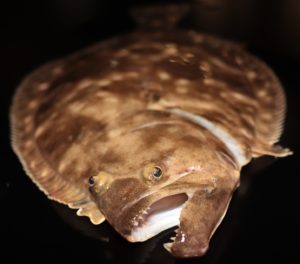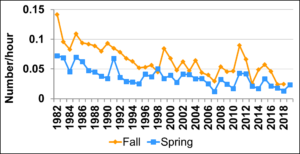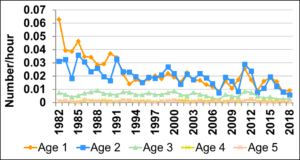One of the most popular fish on the Texas coast continues to struggle and additional measures must be taken to prevent additional declines.

Southern flounder, Paralichthys lethostigma (meaning parallel fish that forgot its spots), are one of the more peculiar fish native to the Eastern and Gulf Coasts of the United States. As juveniles and adults they can survive in bodies of water ranging from freshwater rivers and lakes to bays and offshore. That ability to tolerate varying salinities has allowed them to be widely distributed throughout our coastlines and historically highly abundant during seasonal spawning migrations. Their range begins in northern Mexico and extends through North Carolina, with a slight absence of presence around the tip of Florida. This wide distribution, coupled with their fighting ability and quality of flesh, make them one of the most prized catches among coastal anglers.
While they spend most of the year inshore feeding on invertebrates and smaller fish, adult southern flounder migrate to offshore waters each year during the late fall and early winter to depths of over 100 feet to spawn (some flounder have been found at depths greater than 350 feet), releasing on average 45,000 eggs per pound body weight.
After the eggs are fertilized in the water column, they float to the surface and, dependent on the water temperature, will hatch after an approximate 48-hour incubation period. A colder incubation temperature would equate to a longer incubation. After hatching, the larvae (measuring ~0.1 inches), will feed off their yolk sac for nearly a week, during which time the young fish develop their eyes located on opposite sides of the head. The fish will begin feeding on prey items after the mouth parts and digestive tract have formed, and for the most part, they look like a “normal” fish larvae at this point of their life. Over the next approximately 30-40 days (again, dependent on water temperature), something truly remarkable happens. Losing their aura of ordinary larval fish, southern flounder will undergo a metamorphic process in which the skull bones bend and shift positions as the right eye migrates to the left side of the head. During this process the fish will swim at a slight angle, and pigmentation on the left side (top side) of their body begins to develop. Once the right eye is in its final resting position, the fish settles onto the right side of its body and becomes a true flatfish for the remainder of its life (interestingly, a small percentage of southern flounder larvae undergo left eye migration, which makes one wonder if eye dominance plays a role in metamorphosis). It is just after metamorphosis when the flounder can tolerate variable water conditions, allowing them to thrive in bays and estuaries as they migrate from offshore.
Imagine the energy demand required and resultant stress for an eyeball to move across a head, shifting skull bones in the process. Everything has to be in sync to pull off that feat. Unfortunately for flounder there are factors outside of their control that highly influence successful metamorphosis. One of the most important abiotic factors that drives flounder development in offshore waters is temperature. In the Gulf of Mexico, young southern flounder larvae thrive at 62-65°F and can tolerate temperatures ranging from 59-73°F. After the flounder complete metamorphosis, that tolerance increases dramatically, but during the first few weeks of a flounder’s life it is absolutely critical that water temperatures remain stable in the mid to upper 60s. Winter water temperatures above that narrow tolerance have devastating effects on southern flounder larvae survivability, and subsequently recruitment into the bays the following spring.
Data shows that flounder stocks are in trouble
Female southern flounder live approximately 7 years. It takes 2 years for most female southern flounder to reach maturity, and due to their relatively short life span, ≤ 5 generations (year classes) contribute to the spawning biomass at any given time. Historically, the stock has been able to recover from back to back warm winters but throw a third or fourth consecutive warm winter into the picture, you begin to have far-reaching implications on the fishery. The colder winter of 2017-2018 provided the stock with a little respite after hitting all-time lows in juvenile recruitment in early 2016 and 2017. Recruitment across a time-series can be viewed in Figure 1. Notice that recent upticks in recruitment were preceded by management changes (2009 and 2014), cold winters, or both.

Figure 1. Southern Flounder Recruitment – Coastwide Seasonal Bag Seine (Jan-Mar) Catch Per Unit Effort
Recruits from the 2018 year class have now entered into the legal slot fishery and anglers across the coast are reporting that flounder stocks have recovered. Reports of increased landings in 2019 is also supported by data collected from bay trawls and gill nets (Figures 2 and 3), and while no one can deny that flounder fishing has improved this year, remember that we are fishing primarily off a single year class.

Figure 2. Southern Flounder Coastwide Bay Trawl Catch Per Unit Effort

Figure 3. Southern Flounder Coastwide Gill Net by Season
The flounder fishery is primarily supported by age-1/age-2 fish, and current 14-inch minimum size restrictions ensure that harvested fish are at least age-1. Figure 4 clearly shows that we are witnessing a rapid and dramatic decline in these fish. Furthermore, the warm winter of 2018-2019 has resulted in the fourth lowest year class recorded since 1982, meaning that we have very few flounder available to enter the slot fishery next year.

Figure 4. Southern Flounder Annual Gill Net Catch Per Unit Effort by Age Class.
Bottom line, the flounder fishery is in trouble. We have one successful year class supporting the bulk of the fishery and absorbing most of the harvest pressure.
Tough Decisions Ahead
Moving forward, fisheries managers are going to be faced with difficult decisions on how to properly manage a mixed commercial and recreational southern flounder fishery that continually struggles to maintain status quo. The Texas Parks and Wildlife (TPW) Commission has acted in the past to increase the relative abundance of southern flounder and it appears that they will need to do more in the future.
In early November, TPW Coastal Fisheries staff briefed the TPW Commission on the status of southern flounder and discussed potential future management options, including further reductions in bag limits, boat limits, extension of seasonal closures, increases in slot size and gear restrictions to increase flounder abundance. We can expect TPW staff to begin the scoping and public hearing process in early 2020 to discuss these options with anglers.
It is likely that we will never get back to the flounder abundance we observed in the 1980’s, but we should do everything within our ability to prevent further declines. All options should be on the table and it is time to answer the tough questions many have had for decades. Why have a commercial fishery for a species at the lowest end of its geographical range? What are the effects of the gigging fishery? Why just a 14-inch minimum size limit and why not raise it to ensure female flounder have 2 years to contribute to spawning biomass? Should the fall closure be expanded? Should we have a spring closure to allow the females to migrate into the bays after they have spawned offshore? These are just some of the questions that need to be asked in the coming months and as we have these conversations, we need to remember that the fate of this resource is at stake.
Imagine if the figures in this article were representing declines in red drum or spotted seatrout. What would be your reaction? What measures would you take to ensure that fishery was conserved for future generations?
Be sure to check out our podcast, CCA Texas Website and read the next edition of Currents Magazine to stay informed on this subject as it moves through the scoping and public hearing process.
Additional Information
- CCA Texas has donated over $1 million to support flounder research and stock enhancement:
- $740,000 to University of Texas Marine Science Institute for facilities and equipment to support larvae research.
- $14,000 to Texas Parks and Wildlife Department for a skiff to aid in flounder broodstock collection.
- $40,000 to Sea Center Texas Hatchery in Lake Jackson for flounder larvae culture equipment.
- $325,000 to Sea center Texas Hatchery in Lake Jackson for a flounder larvae culture building.
- Male flounder average 10-14 inches in length.
- Female length is variable, but a 20-inch fish is approximately 5 years of age.
- With a 17” minimum size limit, nearly 100% of flounder would have reached sexual maturity and have two years to contribute to spawning biomass. With the current 14” minimum size limit, only 50% of the fish reach sexual maturity.
- Flounder like it cold. Warm winters spell trouble for successful flounder recruitment.
- When southern flounders reach sexual maturity at 2 years of age, the males measure 10-14 inches and females measure 15 inches or greater.
- Most male flounder remain offshore year-round after migrating out of the estuary.
- Females spawn small batches of about 45,000 eggs per pound over several days.










